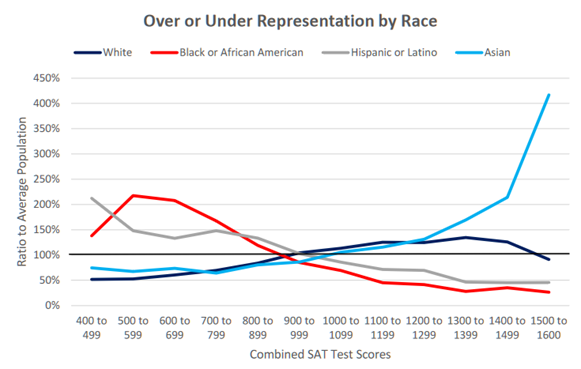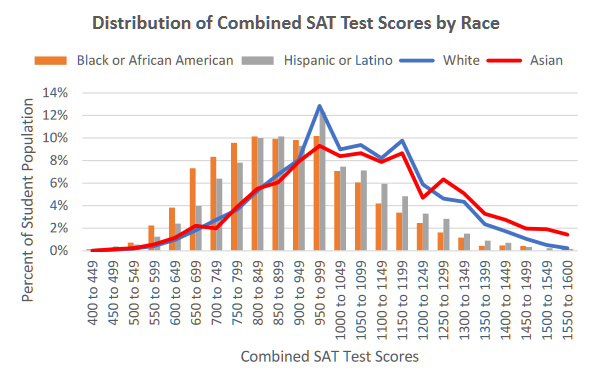 Forum Index
»
College and University Discussion
Forum Index
»
College and University Discussion
Will Admissions Officers pick up on clues in application regarding URM?
Anonymous
So.. if an Asian kid writes about how faced discrimination because they were Asian would make them count under the new, invisible URM 'quota'? Or will Asians continue to be considered as the 'other' and discriminated against as they already are? |
Anonymous
Asians have the same thing or more. So it doesn't mean anything. https://www.nbcnews.com/news/asian-america/anti-asian-hate-crimes-increased-339-percent-nationwide-last-year-repo-rcna14282 |
Anonymous
Are you the same poster that wanted to find all Top 1% test takers and then draw red lines around them by race / ethnicity? As in, find the few thousand URMs with 1500-1600 SAT scores and then re-categorize them to see whether or not they can be further sorted? Stand in the mirror and stare at yourself for a few minutes. And maybe say "Candyman" a few times while you're at |
Anonymous
The "black" students who are admitted to Harvard and similar colleges from my kids' private (top DC school) are frequently 25% black. You wouldn't know they were black by looking at them. I'm sure this is the case from many other high schools as well. |
Anonymous
Asian inspiration stories don't count. Come on now. |
Anonymous
I didn't miss it at all. In fact, that statement is made BEFORE the statement I posted. So what the court is saying is that, yes, applicants may discuss race issues in essays and universities may consider them. BUT, if that consideration results in favoritism toward certain races, it is illegal. So, essentially the statement is meaningless from a race-preferences perspective |
Anonymous
+2 Private school parent here. We know many AA kids with a mixed parent and a white parent. Lots of these kids I know have fair, straight hair and look white. Many are also legacies at places like Stanford, Ivies, Williams, Amherst, etc. The fact that people think they can tell someone’s race by looking at them is laughable. Also, I think the PP said a 14-15% admissions rate, not that 14-15% of the student body was black. |
Anonymous
? I'm not that PP. I'm a DP. You stated: "There are enough high stats URMs to get to the 5-6% average at elite colleges for Blacks, 7-8% for Hispanics, and 0 5% for Native Americans." I was asking how you define "high stats". There are at least 10 elite colleges in this country. How many URM score 1500+? Are there enough of them to have a 10 to 15% representation in each of the top 10 elite colleges? 

|
Anonymous
Yes. You only know by looking at the red lined neighborhood they grew up in. You know them, right? Where the homes that would be valued at $1m in Arlington can be had for $300k because of where they are situated? Not familiar? The ones where equity is anemic on a good day? Where families that do everything the by the book for decades just don't enjoy the same benefits as others may? No? Not something with which you are familiar? |
Anonymous
They can't write those essays except for the possibility of discrimination scenarios they experienced. If they've had those experiences, it would make sense for their college counselors to recommend writing about them. Another possibility, if these URMs likely to be high scorers, is that they may have scored high enough on the PSAT to qualify for the College Board National Recognition Programs? Those can be listed in the app itself. This is only a top percent for the racial group, but these students would be able to make their race clear in the app without writing about disadvantage. Would consideration of an academic achievement run afoul of the law if it is race-based? Maybe, maybe not. One might imagine that AOs will be very careful about this, but would they ignore it completely, or once seen, would AOs then lean heavily on other objective and subjective "reasons" to prefer the applicant? Upthread somewhere there were a few posts mentioning high stats URMs not needing preferences to be competitive for admission. But, as we all know, admission to T20s is about a lot more than high stats. ECs, awards, and essays are so important once a student has met the academic standard. This is a game of slight tips. |
Anonymous
Oh my goodness, this person. Here and elsewhere there is a persistent tendency to assume that URMs who are admitted to top schools are economically disadvantaged. I don't know whether this is true on average, but it is much less so than in the general population. |
Anonymous
Just a nerd point here, Asian ability (as the SAT intends to measure it) is likely underrepresented by the SAT, because there are not sufficiently hard questions and so the distribution is approximately right censored. If the SAT included harder questions, this would add more dispersion in the right tail among the best students and the Asian average would be ridiculously high. This is really a remarkable level of achievement. |
Anonymous
From Brookings https://www.brookings.edu/articles/how-racial-bias-in-appraisals-affects-the-devaluation-of-homes-in-majority-black-neighborhoods/ |
Anonymous
What an interesting concept. All they have to do is make SATs super easy so everyone, regardless of race, will get 800. What you don't want to do is introduce more difficult problems, that will widen the gap by far. |
Anonymous
DP. There may not be many, though College Board sorts them by top 10% of PSAT scores for Black, Latino, and Indigenous, and the award winners will have it listed in their apps.
https://bigfuture.collegeboard.org/communities-events/national-recognition-programs/faq Obviously top 10% PSAT scorers for URM groups doesn't mean those students are competitive for T10s, but it seems likely that a subset of these scorers will be the URMs who do score 1500+. So, which way will this go, will College Board phase out this program, or conversely, ramp it up as it is a way to market to URMs? Can AOs consider this in admission decisions or is it merely a marketing tool? College Board's percentile chart for URMs: https://satsuite.collegeboard.org/media/pdf/sat-percentile-ranks-gender-race-ethnicity.pdf |
